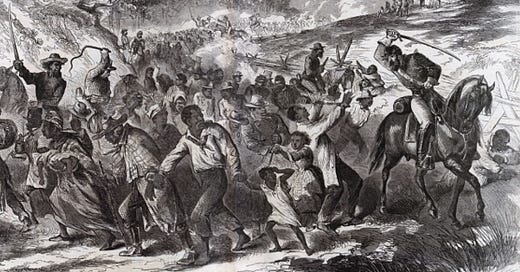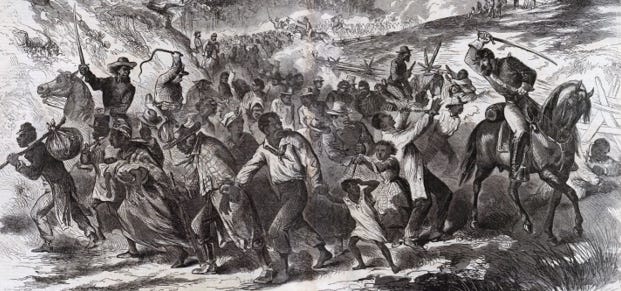Untold Stories: Greencastle's White Citizens Stop Confederates from Enslaving Black Pennsylvanians
In the face of Confederate atrocities, the citizens of Greencastle, PA chose to let skin color unite instead of divide them.
There are so many inspiring, beautiful stories about the great heroes of American history which are scarcely ever told. One happens on them accidentally—buried in a thick, out-of-print biography, in small print on a museum sign, casually and fleetingly mentioned in an obscure educational video. America cannot return to greatness in the future if we do not truly understand the greatness of our past. That is why I am writing an article series to tell a few of these little-known but moving “untold stories” of American greatness. I have previously recounted the stories of Abraham Lincoln and the former slaves of the “contraband” camp, the courage of Union Col. Trimble, and the heroism of slave turned revolutionary Patriot double agent James Armistead Lafayette.
I also previously have touched upon the horrific (and official) practice of the Confederate army (under orders from the Confederate government) to round up any black Americans they could find and enslave them; while the policy supposedly applied to escaped slaves explicitly, it was enforced on any and all blacks the Confederate army encountered. The policy also affected prisoner exchanges, as Confederate Gen. Robert E. Lee told U.S. Grant that “property” (i.e. black Union prisoners-of-war who were supposedly escaped slaves) would not be included in prisoner exchanges, which caused an indignant Grant to cease prisoner exchanges altogether. The Confederate army policy was to enslave or slaughter black Union prisoners-of-war—for instance, future founder of the KKK Gen. Nathan Bedford Forrest carried out at least one unspeakable massacre of black troops and civilians, and their white companions, after the latter surrendered their fort—and to treat the captured white officers of the black troops as practically criminals (often the white officers were butchered along with their black troops).1
This dreadful Confederate policy led to many free black Americans—both newly free and free for their entire lives—to be enslaved and to disappear to history when the Confederates rounded them up and sent them south. Gettysburg’s free black community was decimated by the vicious practice. There were times, however, when loyal Americans fought back against the Confederates. Sometimes the black Americans themselves fought back, though the fact that oftentimes the civilian prisoners were disproportionately women and children meant that the victims were at a severe disadvantage against the Confederate soldiers. This story came from the Chambersburg Repository:
“One Negro effected his escape by shooting and seriously wounding his rebel guard. He forced the gun from the rebel and fired, wounding him in the head and then skedaddled.”
There is one truly inspirational story, however, of a town where the white Americans were so dedicated in their friendship for and loyalty to their black brethren that the Confederates had to leave without the prisoners they so unjustly sought.
“Some white Pennsylvanians refused to sit idly by while their black neighbors were being kidnapped and enslaved. On June 16 four wagons filled with between 30 and 40 black women and children who had been captured at Chambersburg arrived at Greencastle. The wagons were guarded by a Confederate chaplain and four soldiers. Incensed at the injustice they were witnessing, white residents overcame the guards, locked them in the town jail, and freed the captives. The Confederate commander, General Albert Jenkins, threatened to retaliate by burning down the town if the freed blacks were not returned. Fourteen of the captured black women offered to turn themselves over to the rebels in order to save the town. But the white citizens of Greencastle stood firm. They refused to return any of the kidnapped African Americans to captivity. In the ebb and flow of war, Jenkins was forced to move his command away before he could carry out his threat.”
These white Pennsylvanians were willing to risk their own lives and safety, the fate of their town, to stand for what was right and help their fellow Pennsylvanians. Confederates were willing to kill any whites helping blacks, as Gen. Forrest had proved at Fort Pillow, including children, so this was a serious matter enough for Greencastle’s citizens. The citizens of Greencastle refused to let skin color divide them. They let their common American citizenship and common humanity unite them. In modern America, where the Democrats (they no longer call themselves the Confederates, but it is the same party) are still trying to use race and skin color to divide us, let us learn a lesson from the heroes of Greencastle and remember that we are all one community, no matter what our race, ethnicity, or background, a community worth taking great risks to protect and preserve.
(The book The Man Who Saved the Union: Ulysses Grant in War and Peace by H.W. Brands was a source for this article.)
“General James Ronald Chalmers explained to the Times correspondent that the Confederate troops were following orders. It was official policy to kill wounded Black Union soldiers and anyone who surrendered, as well as White officers who served with Black troops.
In battle dispatches, General Forrest wrote, ‘The river was dyed with the blood of the slaughtered for two hundred yards. The approximate loss was upward of five hundred killed, but few of the officers escaping. My loss was about twenty killed. It is hoped that these facts will demonstrate to the Northern people that negro soldiers cannot cope with Southerners.’”




